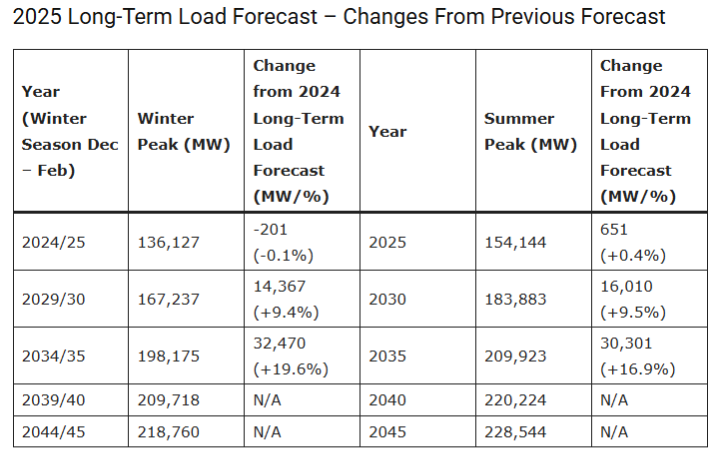As load growth explodes, PJM could shatter records this winter—with much more demand on the way.
Load growth continues to dominate the conversation around PJM, and for good reason. The region is experiencing exponential demand increases that are expected to continue year over year.

Average PJM load jumped sharply across all hours of the day in 2025, as in this example from February, and is expected to continue growing rapidly.
Electrification and Weather Could Drive Record-Shattering Load This Winter
Looking ahead to winter, PJM remains a summer-peaking ISO, but the balance is beginning to shift as electrification accelerates, particularly with the growing adoption of electric heat pumps and the gradual phase out of gas and oil heating.
Last winter set a new record peak just shy of 144 GW on the morning of January 22, 2024. This year, PJM is forecasting a new record-setting winter peak of 145,700 MW. To prepare, PJM is taking additional precautions, including unannounced generator tests to ensure grid reliability.
Amperon’s mid-term forecast ensembles currently show maximum members forecasting peak demand above 150 GW in early February. This level of winter demand would shatter conventional expectations. Based on current trajectories and this winter’s volatile outlook, however, we feel this scenario is entirely plausible.
PJM’s Long-Term Forecast Shows Exponential Load Growth
By the 2029–2030 season, PJM projects winter peak demand could reach 167 GW. According to PJM’s 2025 Long Term Load Forecast, winter peak demand is projected to rise by nearly 30 GW in just five years.
Beyond that, forecasts suggest the 2034/2035 winter peak could approach 200 GW, while the 2035 summer peak may climb to around 220 GW. This is a notable departure from what PJM was forecasting just last year.

2035 peaks could be nearly 20% higher than previously forecasted.
Even thinking back to this summer, on June 23, 2025, the PJM grid hit 160.2 GW during Hour Ending 18 (HE18), the highest demand in over a decade. That’s well above the 154 GW PJM forecasted for this summer’s peak. This was caused by widespread extreme heat across the ISO in addition to load growth.
Behind-the-Meter Resources Could Change PJM’s Outlook
The key question remains whether this projected growth will truly occur. Much of the anticipated demand is tied to new data centers, many of which have yet to come online. Even when they do, not all of their load will necessarily hit the grid. Some large companies are planning to power facilities with behind-the-meter or co-located resources such as nuclear, natural gas, or battery storage.
For instance, Microsoft and Constellation recently signed a power purchase agreement to restart the Three Mile Island Unit 1 nuclear reactor, which will supply power to Microsoft’s AI operations while advancing its carbon-free energy goals. Similarly, Google and TotalEnergies signed a power purchase agreement for 1.5 TWh of renewable energy from TotalEnergies’ solar farm in Ohio.
While solar generation typically peaks outside of system demand hours and thus has limited impact on peak management, the trend becomes more complex as companies secure energy from constant output resources like nuclear. These arrangements do not expand the grid’s supply stack, but they can effectively reduce the portion of data center demand that draws directly from the ISO.
Capacity Prices Show Lasting Opportunity for Power Producers
Even if some of this load is served behind the meter, however, PJM faces a growing challenge: can its generation stack keep pace with surging demand? Recent capacity auctions have reflected tight supply and demand conditions, with record-breaking clearing prices that are not expected to decline in the near term. This means lasting opportunity for power producers who can build and bid optimally.
A combination of rising demand, retiring coal plants, and slow resource additions are driving these dynamics. The central question is whether enough new generation capacity, particularly from reliable and dispatchable sources, can be added to sustain PJM’s rapid load growth.
In any scenario, changing grid dynamics are a certainty. PJM market participants will need to be prepared to meet the moment with intelligent decision-making powered by continuously learning forecasts.








.avif)

.avif)









